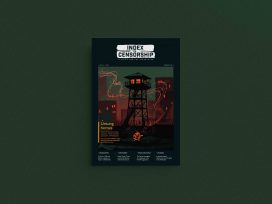In August 1969, eight years almost to the day after the advent of the Berlin wall, rioting in Belfast led to the hasty erection of a peace-line between the Protestant Shankill and Catholic Falls Road, or rather, for most of its length, between the Shankill and Springfield Roads. Thirty-five years on – 15 years from the fall of the Berlin wall, ten years from the IRA ceasefire, six years from the Good Friday Agreement – that “temporary” peace-line, reinforced and extended to over half a mile, still stands; as do the 16 others created in its image in various contentious parts of the city. The greatest concentration, like the greatest concentration of murders during the conflict, is in north Belfast, including one, erected since the Agreement, through the middle of a public park.
Protestants and Catholics may for the most part have stopped killing one another but that is not to say that they are ready to live side by side.
This was never, by any stretch of the imagination, an integrated city, but it is a more profoundly divided one now than at any time in its history. Whereas two-thirds of Belfast citizens were estimated to be living in segregated streets in the 1960s, by the 1980s the figure had risen to four-fifths. Evidence suggests that figure has gone on rising. In his book The Trouble With Guns (Blackstaff Press) writer and magazine editor Malachi O’Doherty, a Catholic by birth, tells how during the riots of 1969 he was trying to make his way home from the Shankill Road where he was then working as a barman. Finding himself lost he asked for – and was given – directions to the Falls. It is almost impossible to imagine such a scenario today. Nor is it easy to see how the current divisions can be reversed. Where once there were through-roads now there are cul-de-sacs; housing at many traditional flashpoints has been cleared altogether and retail developments, industrial parks, even motorways built as de facto buffer zones.
With their backs turned to one another these segregated areas are often further divided into paramilitary zones of influence. If flags and painted kerbstones – green white and orange or red white and blue – will tell you whether you are in a Catholic or Protestant part of town, murals are usually the best guide to which organisation holds sway there. A BBC Northern Ireland investigation earlier this month into antagonisms between loyalist paramilitaries was aptly entitled “Feudal Times”. Though East Belfast has been the focus of the most recent feud, the bloodiest and most protracted remains that which in the summer of 2000 split the Shankill Road, Korea-like, between an upper (UVF) end and a lower (UDA) one. Scores of families were put out of their homes. According to one contributor to “Feudal Times”, the Road is still traumatised by the events.
My mother’s family are Shankill people. A few years back my brother and I drove an uncle, home from Australia, around the streets where he had grown up. He was visibly shaken by the depredations.
It is all the more remarkable, then, that the Shankill has just picked up a “Keep Britain Tidy Award” after an initiative that has seen the removal of 27 murals, sectarian graffiti, and paint from 7,000 metres of kerbstones. This is not – as one over-enthusiastic press agency suggested – “the last vestiges of the Troubles [being] scrubbed away”, but it is a start.
In another recent development, senior figures in Sinn Fein and the Democratic Unionist Party issued what appear to have been synchronised calls for a quiet summer in Belfast. (Summers here have traditionally been hot for all the wrong reasons.) Mobile phones, meanwhile, have been issued to community workers either side of certain of the peace-lines to allow them to communicate and mediate at the first signs of trouble.
And all the time housing is returning to the city centre itself, reversing decades of population decline. In keeping with other cities in Britain and Ireland, much of this housing consists of apartments for young singles: “yuppie flats” as they are still somewhat anachronistically referred to. So far these developments have been largely free of sectarian tension and iconography, though only last month there were ugly demonstrations outside an apartment block on Sandy Row, a working class Protestant district behind the city’s “golden mile” of restaurants and bars, after rumours that an Irish flag had been waved from one of the windows. Of even greater concern are the attacks in both Catholic and Protestant parts of the city on members of Belfast’s still small ethnic communities. In loyalist areas in particular there has been clear evidence of paramilitary involvement.
It seems that while the peace-lines are undeniably popular with those living within a stone’s – or a petrol bomb’s – throw of the other side (and who knows, were I living there myself they might be popular with me), they have perpetuated into our heavily processed peace a worldview where there are really only two types of people: “us” and “not-us”.
There are still many thousands of metres of kerbstones to go.
Published 12 August 2004
Original in English
Contributed by Index on Censorship © Index on Censorship / Eurozine
PDF/PRINTNewsletter
Subscribe to know what’s worth thinking about.



